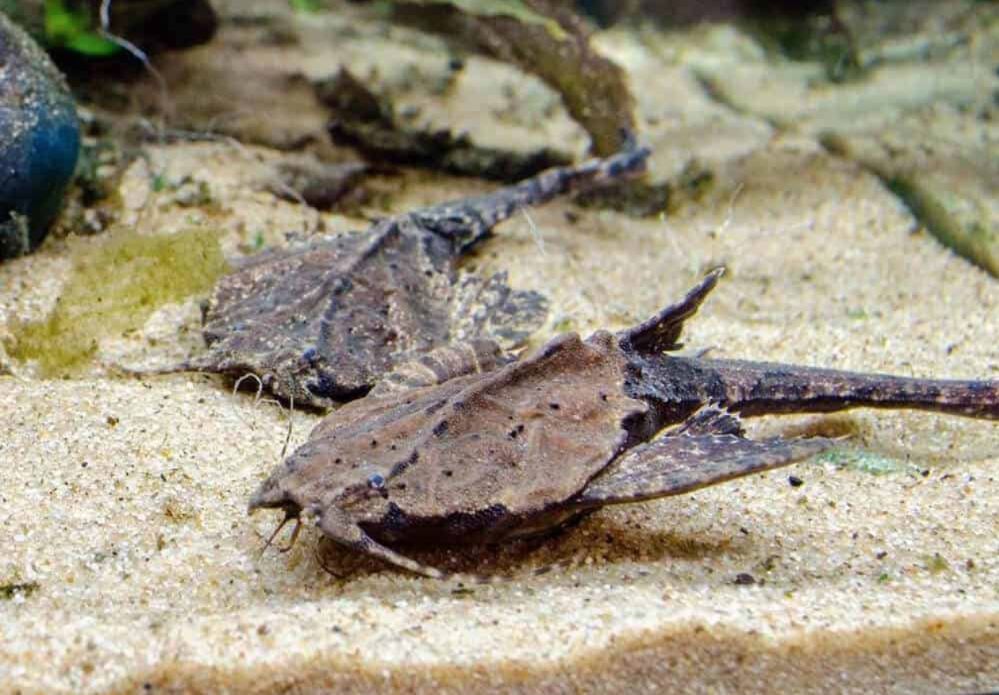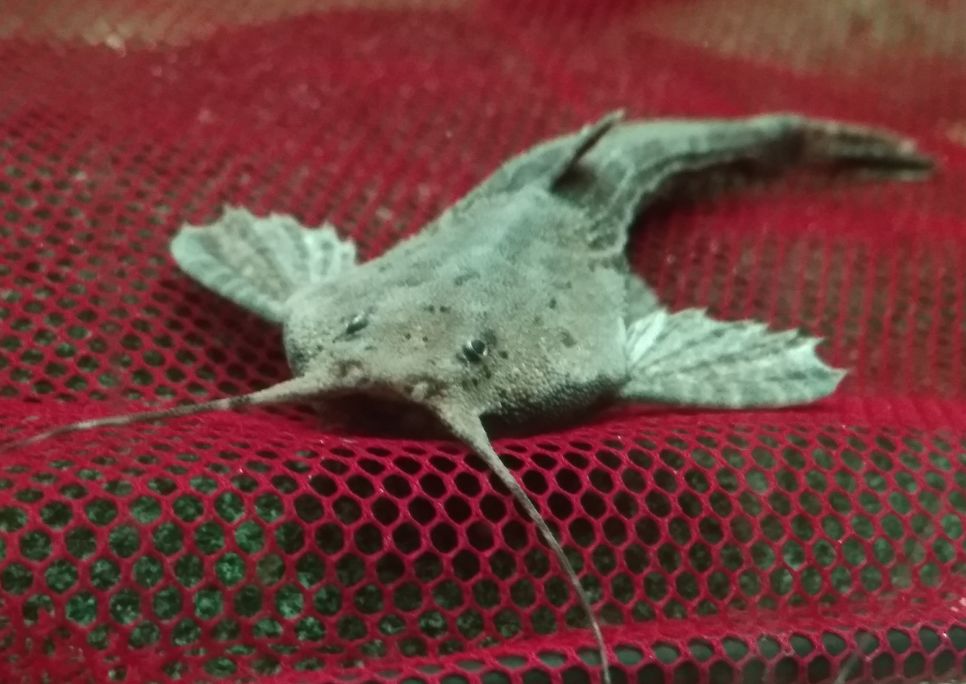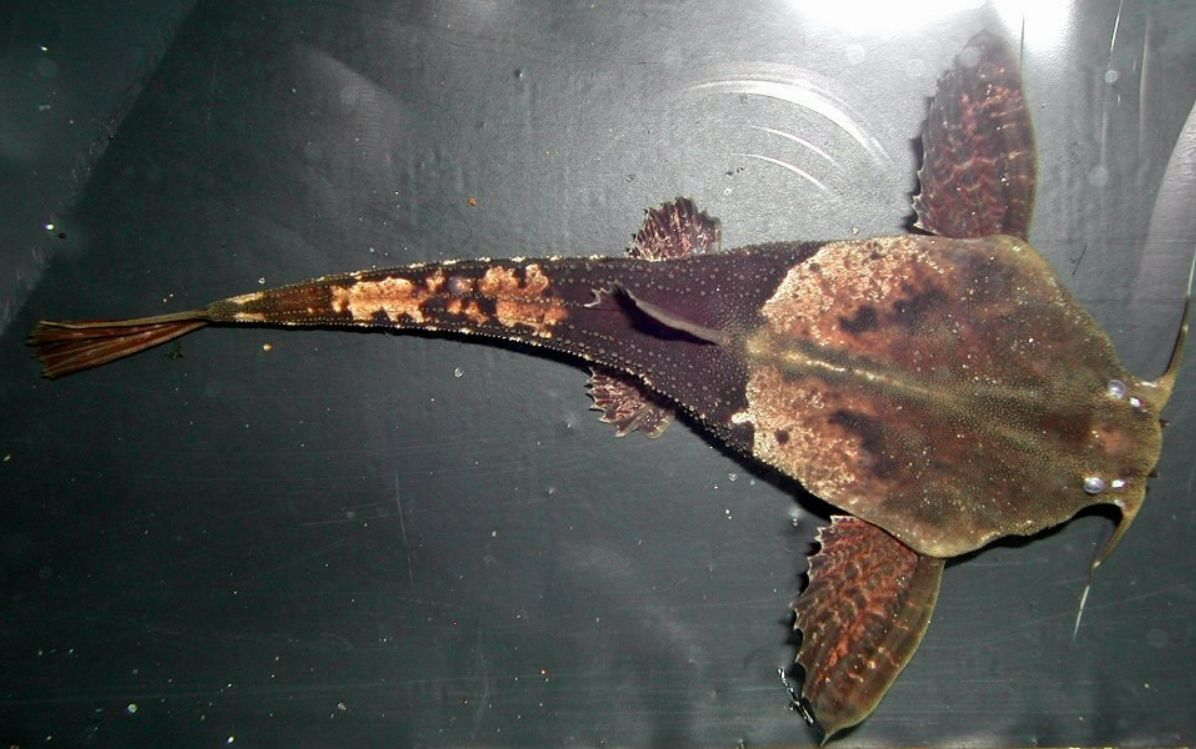The banjo catfish (Bunocephalus coracoideus) is a rare sight in home aquariums, but its distinctive appearance suggests it may become a popular choice in the future. In North America, it is commonly referred to as the banjo catfish due to its resemblance to a banjo, while in Latin America, it’s known as the Guitarrita catfish, reflecting its guitar-like body shape.
The banjo catfish stands out with its unique, flat body and distinctive shape, making it a conversation starter and a fascinating addition to any aquarium. Its unusual appearance not only sets it apart from more common catfish but also highlights the diverse beauty of aquatic life.

Contents
Habitat in the wild
The term “banjo catfish” refers to the genus Bunocephalus, a group of small catfish species native to South America. These intriguing fish inhabit various river systems within the Amazon Basin, including the Amazon River and its tributaries in Bolivia, Uruguay, Brazil, and Peru.
Banjo catfish prefer environments with slow-moving water, such as streams, ponds, and small lakes. They thrive in areas with muddy or sandy substrates, where they blend seamlessly with their surroundings. These catfish are often found among debris like snags, branches, and fallen leaves, which they use for both hiding and foraging.
Though they are typically solitary, banjo catfish may occasionally form small groups. They are commonly associated with densely vegetated areas, where submerged roots, fallen branches, and other debris provide them with essential cover and protection from predators. This natural camouflage allows them to pursue their scavenging habits effectively in their preferred habitats.

Description
Body and color
The banjo catfish boasts a highly specialized body structure adapted for camouflage and concealment. Its body is notably flattened and tapers into a cone-shaped tail towards the dorsal area. This unique shape helps the fish hide beneath snags and burrow into fallen leaves on the riverbed. The catfish’s khaki coloration, with large dark splotches on a sandy yellow background, mimics the appearance of tree bark, allowing it to blend seamlessly with its surroundings. In its natural habitat, this effective camouflage makes it nearly invisible against a backdrop of fallen leaves.
Each species of banjo catfish features a distinct pattern of dark and light spots. Its rough, knobby skin further aids in blending with the environment and provides additional protection. The fish’s fins, which are well-developed and match its body coloring, include a sharp spine on the first ray of the pectoral fin.
Unlike many other fish, the banjo catfish lacks a fatty fin, a trait that evolved over time. It has large, wide-set mouth with six barbels and very small, dark-colored eyes. The tail fin is long, and the pectoral fins vary in size, contributing to its unique and effective design for life in its specific habitat.
Size
The banjo catfish, belonging to the genus Bunocephalus, typically grows to a size ranging from 2 to 6 inches (5 to 15 cm) in length. However, size can vary significantly among different species within this genus.
Specifically, Bunocephalus coracoideus, commonly known as the Banjo Catfish, generally reaches a maximum length of about 2 to 3 inches (5 to 7.5 cm). This species is notably smaller compared to some of its relatives in the catfish family.
Lifespan
Banjo catfish typically have an average lifespan of 5 to 8 years when kept in captivity. With optimal care and a well-maintained environment, some individuals may exceed this range and enjoy even longer lives.
| Characteristic | Description |
|---|---|
| Scientific Name | Bunocephalus coracoideus |
| Common Name | Banjo catfish, banjo fish, bango catfish, banjo cat, banjo pleco |
| Origin | South America, primarily Amazon basin |
| Habitat | Freshwater rivers, streams, and flooded areas |
| Body Shape | Flattened body with a wide head and long, slender tail |
| Size | Typically small, ranging from 2 to 3 inches (5 to 7.5 cm) |
| Coloration | Light brown or gray, providing camouflage |
| Behavior | Nocturnal, primarily bottom-dwelling |
| Diet | Algae, organic matter, small invertebrates |
| Compatibility | Peaceful, suitable for community aquariums |
| Aquarium Requirements | Well-maintained aquarium, hiding spots, soft substrate |
| Water Parameters | pH: 6.5-7.5, Temperature: 72°F-82°F (22°C-28°C) |
Difficulties in keeping
Despite its exotic appearance, the banjo catfish is relatively easy to care for and feed. It thrives in an aquarium with plenty of hiding spots and subdued lighting, which mimics its natural habitat.
As a nocturnal species, the banjo catfish prefers to be fed in the evening or at night. Its calm demeanor means it may not compete with other tank inhabitants for food during the day, so feeding it at night ensures it gets the nutrition it needs.

Care and keeping in a tank
Banjo catfish doesn’t require any special keeping conditions. It easily adapts to various tank conditions, the main thing is to keep the tank bottom substrate clean; standard water renew scheme – up to 20% every week.
As for the temper – this is a nocturnal tank dweller. During the day it stays in shelters or hides using peat, small grained sand or finds some dark corners under snags or stones. The fish is good at masking and it may dig itself into the sandy substrate and stay there for a long time without giving any signs of life. The fish becomes very active in the evening. Catfish starts actively searching for food by going through the whole tank bottom.
Tank size
Banjo catfish are relatively small fish and do not require a large tank. However, it’s important to provide them with sufficient space to swim and explore. A general guideline for tank size is to provide a minimum of 10 gallons (38 liters) of water per banjo catfish.
Keep in mind that it’s always better to provide a larger tank if possible, as it can offer more swimming area and allow for better water quality and stability. Providing a larger tank also gives you the opportunity to create a more natural and enriched environment with hiding spots and suitable substrate.
Water parameters
For optimal health, banjo catfish require the following water conditions:
- Temperature: Maintain a range of 72°F to 82°F (22°C to 28°C).
- pH: Slightly acidic to neutral, ideally between 6.5 and 7.5.
- General Hardness (GH): Between 5 and 15 dGH.
- Water Changes: Regularly change 1/3 of the tank water with fresh water to ensure a clean environment.
The tank should also be equipped with filtration and aeration systems to maintain water quality and provide adequate oxygenation.
Substrate
Use a fine-grained substrate such as sand or smooth gravel. As bottom-dwelling fish, banjo catfish benefit from a soft substrate that allows them to comfortably search for food and burrow.
Decor
Provide driftwood or roots in the aquarium. These items mimic the submerged branches and root systems found in their natural habitat, providing hiding places and creating a more natural environment. Arrange some smooth rocks or caves in the tank to create hiding spots for the banjo catfish. These fish appreciate secure places to retreat and feel safe.
While providing hiding spots is important, make sure to leave ample open space for the banjo catfish to swim comfortably. They appreciate having areas to explore and patrol.
Include some live or artificial plants in the aquarium. Banjo catfish are typically found in habitats with dense vegetation, so having plants like Java ferns, Anubias, or Amazon sword plants can provide them with cover and add aesthetic appeal to the tank.
Diet
Banjo catfish are omnivorous and not particularly picky about their food. They will feed in the evening when they emerge from their shelter to search for food.
Although they may nibble on algae, banjo catfish are not primarily algae eaters like some other catfish species, such as plecos. Instead, they are opportunistic feeders, consuming a range of food sources including organic matter, small invertebrates, and decaying plant material.
To ensure a varied diet and mimic their natural feeding behavior, offer occasional live or frozen foods. Suitable options include small live or frozen invertebrates such as bloodworms, brine shrimp, daphnia, and blackworms. These foods are rich in protein and beneficial for their overall health.
As a staple part of their diet, provide high-quality sinking pellets specifically formulated for catfish or bottom-dwelling fish. These pellets should be designed to meet their nutritional needs and be appropriate for their small mouth size.
Tank mates
Definitely, no. The fish feels quite comfortable in a community tank, but since it is a nocturnal fish species it can be seen very seldom. This fish can live alone or in a small school of its kind. Since banjo catfish primarily occupy the lower regions of the aquarium, it’s best to select tank mates that occupy different areas of the tank. Look for species that inhabit the mid to upper levels of the water column, allowing for a harmonious distribution of space.
Choose peaceful fish species that are not aggressive or prone to fin-nipping. Avoid keeping them with large, aggressive species that may intimidate or harass the banjo catfish.
Banjo catfish should be kept with other small, active fish species.
Some suitable tank mates for banjo catfish can include peaceful community fish such as tetras (e.g., neon tetras, ember tetras), rasboras, small livebearers (e.g., guppies, endlers), small peaceful cichlids (e.g., Apistogramma species), and small catfish species (e.g., Corydoras, Otocinclus). However, it’s important to research the specific needs and temperament of any potential tank mate species to ensure compatibility.
Always monitor the behavior of the tank mates when introducing them to the aquarium and be prepared to make adjustments if any aggression or incompatibility arises. Providing adequate hiding spots and territories can also help reduce stress and promote harmonious interactions among tank mates.
Gender differences: male vs female
Banjo catfish do not exhibit pronounced sexual dimorphism. However, females are generally larger and bulkier than males. This size difference is the most noticeable indicator of gender among these fish.
Breeding
Spawning in banjo catfish is triggered by several factors, including fresh, oxygen-rich water, strong water flow, and sometimes a minor hormone injection.
Banjo catfish typically spawn at night. During this time, they exhibit vigorous swimming behavior, often appearing to hover in the water flow created by a tank filter. After a period of separation, the fish regroup near the water surface. The male will embrace the female, and she releases a small batch of eggs, which the male fertilizes immediately. Following this, the fish disperse again, and the process may be repeated multiple times.
The eggs are small, bright green, and sticky, resembling those of kuhli loaches, and are scattered evenly across the tank bottom. A net is not required to protect the eggs, as banjo catfish do not consume them. A typical spawn consists of approximately 200-300 eggs. The incubation period lasts 36-48 hours at a tank temperature of 26°C.
After two days, tiny larvae emerge. Within an additional two days, these larvae develop into juveniles, which tend to seek shelter in small crevices due to their natural photophobia. On the 4th to 5th day, the juveniles begin to develop their coloration.
Feeding juveniles requires the smallest live organisms, such as cyclops nauplii and rotifers. Maintaining high water quality is crucial during this stage. The first month of the juveniles’ lives is particularly challenging for the aquarist. However, with proper care, most of the juveniles will survive and grow. As they mature, you can gradually introduce larger food items.
Banjo catfish typically reach reproductive maturity at around 12 months of age.